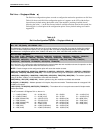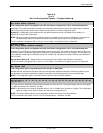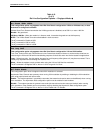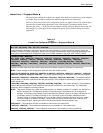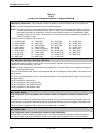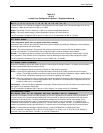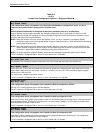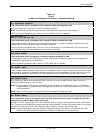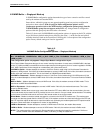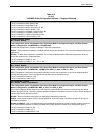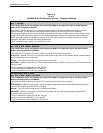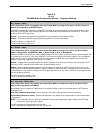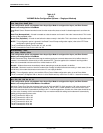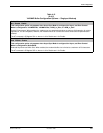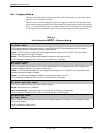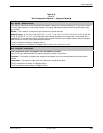
COMSPHERE 392xPlus Modems
4-58 November 1996 3920-A2-GN31-30
V.42/MNP/Buffer — Singleport Mode A
V.42/MNP/Buffer configuration options determine the type of error correction and flow control
used by the modems and attached DTEs.
Some choices within this group may not appear depending upon how previous configuration
options have been selected.
If the Async/Sync Mode configuration option is set for
synchronous operation (refer to the DTE Interface configuration options group), then the
V.42/MNP/Buffer group does not appear on the LCD. Any changes made to configuration
options within this group only take effect after a disconnect.
T
able 4-12 shows each V
.42/MNP/Buffer configuration option as it appears on the LCD, with the
Async Dial factory default setting shown following the colon ( : ) on the first line and with all
available selections listed on the second line. Following this is a description of the configuration
option. Factory default settings are listed in Appendix F.
Table 4-12
(1 of 6)
V.42/MNP/Buffer Configuration Options — Singleport Mode A
Err Contrl Mode: V42/MNPorBfr
Nxt V42/MNPorBfr V42/MNPorDsc MNP_or_Buffr MNP_or_Disc BufferMode DirectMode LAPM_or_Disc
LAPM_or_Bufr
This configuration option only appears if Async/Sync Mode is configured for Async.
Error Control Mode. Determines the type of error control used by the modem. In most cases, V42/MNPorBfr is the best
choice. If V.42bis and MNP are enabled, then the modem uses the following priority for error control negotiation: V.42bis,
V.42, MNP 5 and below. Online changes do not take effect until a disconnect occurs.
V.42/MNP or Buffer – Modem attempts to connect in V.42 Error Control mode using V.42 Link Access Procedure for
Modems (LAPM) protocol. If this fails, the modem attempts to connect in MNP mode. If this fails, the modem connects in
Buffer mode and continues operation. This is also known as V42/MNP Autoreliable Mode.
V.42/MNP or Disconnect – Modem attempts to connect in V.42 Error Control mode using V.42 LAPM protocol. If this
fails, the modem attempts to connect in MNP mode. If this fails, the modem disconnects. This is also known as Reliable
mode.
MNP or Buffer – Modem attempts to connect in MNP mode. If this fails, the modem connects in Buffer mode. This is
also known as MNP Autoreliable Mode.
MNP or Disconnect – Modem attempts to connect in MNP mode. If this fails, the modem disconnects. This is also
known as Reliable mode.
Buffer Mode – Modem does not use error control and allows the DTE rate to differ from the communications line rate.
This mode should only be used if the DTE provides its own error control or if errors in data can be tolerated. This setting
is also known as Normal mode and is valid even if the remote modem is set to Direct mode.
Direct Mode – Modem connects at a data rate equal to or less than the initial DTE interface rate. (The modem never
connects at a data rate greater than the initial DTE rate.) If the modem connects at a data rate lower than the DTE rate,
the DTE must then adjust its data rate to equal the modem rate. Ultimately, the modem speed and DTE speed must be
the same. Direct mode does not support error control or data buffering.
LAPM or Disconnect – Modem attempts to connect in LAPM mode. If this fails, the modem disconnects.
LAPM or Buffer – Modem attempts to connect in LAPM mode. If this fails, the modem connects in Buffer mode.
NOTE: The modem must be reconfigured for Direct mode before changing the leased-line modulation if V.42 error
control or Buffer mode are enabled with V.32bis, V.34 family, or TMp on leased lines.



